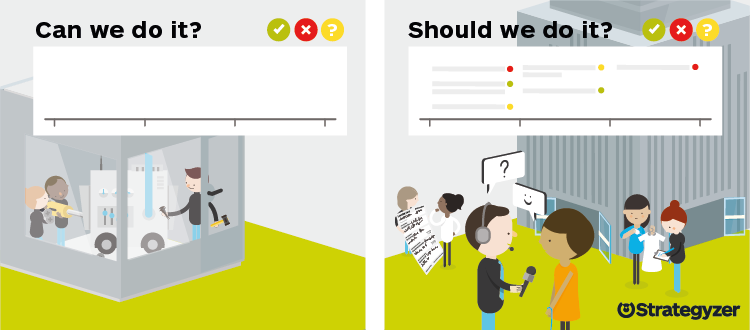
I don’t see enough companies clearly distinguishing the difference between “should we do it” and “can we do it” when building new ventures.
For example, the large companies I work with have enormous R&D budgets. However, their budget mainly goes towards solving hard technological or product problems. In other words, R&D is mainly focused on “can we do it” product and technology questions at the expensive of cracking hard market, business model or value proposition questions.
Only a tiny proportion--if any--is allocated to the question “should we do it?” by testing market risk, opportunity, and appropriate business models and value propositions à la Lean Startup.
Similarly, you’ll see entrepreneurs with a scientific, research, and engineering background get super excited about solving a technical problem--let’s say medicine that can cure a tough disease--without a sufficient and deep understanding if there’s an appetite for that solution. Will supply chain partners work with you? How will payers react to the new solution? Will medical professionals and patients be receptive? How does this fit into the current and future regulatory environment?
Corporate R&D and entrepreneurs need to focus a lot more on the “should we do it” in addition to the “can we do it”. Let’s quickly run through the definitions:
Should we do it: Is there customer acceptance for the problem we are trying to solve? Can we build a value proposition and business model that’s scalable? Can we prove it?
Can we do it: Can we build the technology, product or service? Will it be difficult, costly, or near impossible to produce the solution we have envisioned?
You can understand customer priorities and other market risks without building an expensive solution or even prototyping at all.”
Alex Osterwalder
Co-founder of Strategyzer
Every new venture must deal with the question of “should we do it?”, while the “can we do it?” depends on how difficult it is to develop the underlying technology.
Of course you might argue that marketers conduct market studies on the market opportunity before companies invest in R&D. Yet, they rarely test the market enough to know if they’ve cracked the “should we do it” problem. That’s why the Lean Startup process is so valuable, because it focuses deeply on the question if a company should or shouldn’t pursue a venture.
Before even thinking about the (technological) solution, you really want to understand the jobs, pains, and gains of your target market. You also want to understand what variables will matter in your business environment. Is the timing right? What’s the market size? Is there revenue potential? How will you acquire customers?
So how can you understand your market opportunity and risk first, before focusing too deeply on technological or product challenges? There are many, many possible ways to conduct customer discovery and customer experiments.
On our blog we’ve portrayed three concrete approaches you could take among the many possibilities in the Lean Startup arsenal:
- Customer interviews can create a dialogue between you and your audience. The discussion can uncover what matters to them.
- Our card sorting exercise allows you to prioritize jobs, pains, and gains by collaborating directly with customers.
- And these two co-creation exercises further paint a picture of what your customers want.
The real kicker here: you can understand customer priorities and other market risks without building an expensive solution or even prototyping at all.
It’s important to step outside of your bubble. The solution you are excited about may solve a challenging problem, but you’ll want to find out whether or not anyone even cares about what you are building. This will not only save your venture money, it’ll reduce the uncertainty of risk and result in a potential company that understands what customers really want.
What other ways can companies test the "should we do it?" assumption?





